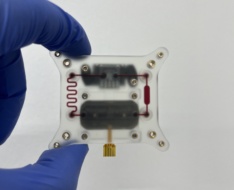Asteroid bits from millions of miles away have been safely delivered to Earth’s doorstep.
After its seven-year journey, the OSIRIS-REx spacecraft flew by Earth yesterday, tossing down a capsule carrying an estimated 250 grams of extraterrestrial regolith.
The capsule parachuted down to the DoD’s Utah Test and Training Range and safely landed right-side up. The craft was then promptly scooped up and flown via helicopter to a temporary clean room, where it is being fed nitrogen gas to prevent contamination. The canister is scheduled to fly to Johnson Space Center today, where it will be opened and the samples will be weighed.
The mission’s primary objective is to better understand how our planet formed and the origin of life on Earth.
- “One of the driving objectives of this program is to try to understand if carbon-rich asteroids, like Bennu, deliver the compounds that may have led to the origins of life on our planet,” program principal investigator Dante Lauretta said in a post-mission press conference.
The regolith will undergo years of testing by domestic and international scientists.
A rocky reentry: The one hiccup that had Lockheed, NASA, and space nerds worldwide holding their breath was in parachute deployment. The first, smaller drogue parachute may have malfunctioned as the team could not visually confirm its deployment. Also, the main parachute deployed 4,500 m higher than expected. But with the capsule safely on Earth, no harm, no foul.
Asteroid → Earth: The asteroid sample return marks a first for NASA, but not a first for the world. Japan nailed the feat twice by returning samples from asteroid Itokawa in 2010 and then Ryugu in 2020—though the samples recovered were a fraction of the estimated 250 grams brought home by NASA.
☄️ How we got here: NASA launched OSIRIS-REx in 2016 on a two-year journey to Bennu. After reaching the asteroid, NASA discovered a rocky world with limited safe clearings.
- Following a trajectory adjustment, the spacecraft descended to the asteroid with a collector arm leading the way.
- The arm plunged more than a foot into the regolith debris, collecting samples for a matter of seconds, before hastily getting out of dodge.
- Scientists believe they were able to secure four times as much regolith as expected.
What’s next: The OSIRIS-REx spacecraft’s mission didn’t end with the sample delivery. Now it’s off to survey the next asteroid, Apophis.




